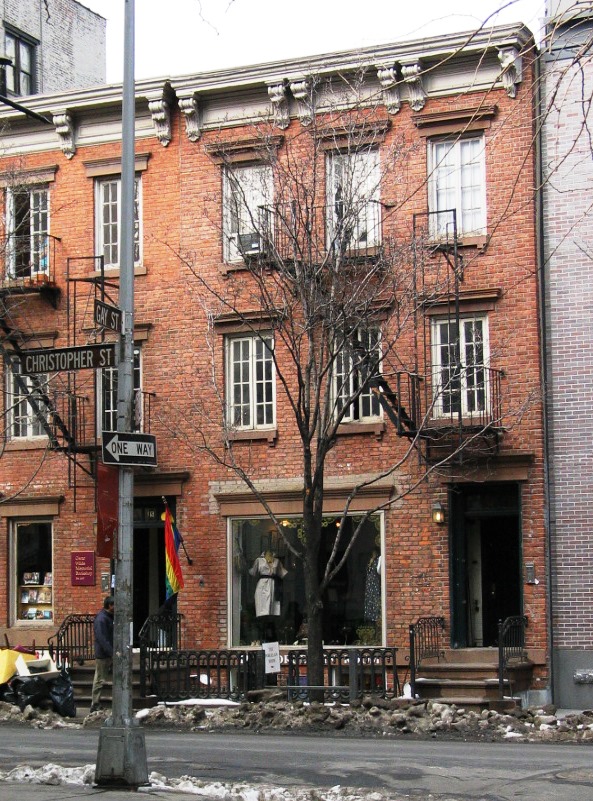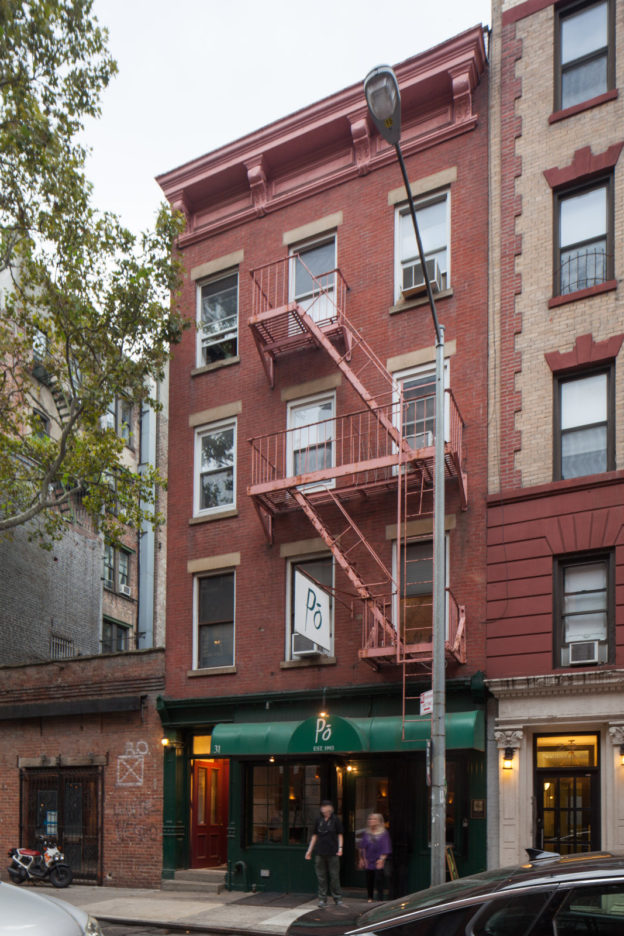WOMEN
207 St. Paul’s Avenue, Staten Island
1898
Otto P. Loeffler
From 1972 to 1987, acclaimed African- American lesbian writer and activist Audre Lorde (1934-1992) lived in this neo-Classical house with her two children, Elizabeth and Jonathan, and her partner, Frances Clayton. Lorde accomplished a great deal while living here, including the publication of numerous influential books, poems, articles and essays that dealt with the issues of civil rights, feminism and lesbianism; held positions as professor of English at John Jay College and as the Thomas Hunter Chair of Literature at Hunter College; spoke at the 1979 National March on Washington for Lesbian and Gay Rights; co-founded Kitchen-Table: Women of Color Press and was bestowed with many honors, including the Borough of Manhattan President’s Award for Literary Excellence in 1987. From 1991 until her death from liver cancer the following year, Lorde was the New York State Poet Laureate. Photo by Sarah Moses, NYC Landmarks Preservation Commission. Audre Lorde’s house is a NYC Individual Landmark located in the St. Paul’s Avenue-Stapleton Heights Historic District.
LGBTQ
78th Street & 37th Avenue, Queens
On July 2, 1990, Julio Rivera, a 29-year-old Jackson Heights resident, was attacked by three gang members in the playground of P.S. 69 because of his sexual orientation. He died from his wounds at Elmhurst Hospital, and his death sparked a surge in LGBTQ activism in Queens. While there had been many more hate crimes toward gay people in Queens over the previous few decades, the vigil for Rivera on August 18, 1990, was considered to be Queens’ first successful LGBTQ public demonstration. The vigil, organized by Rivera’s family and friends and a coalition of LGBTQ activists and organizations, led to other advocacy efforts, including the formation of Queens Gays and Lesbians United, the Lesbian and Gay Democratic Club of Queens, Queens Pride House and the organization of two more demonstrations to pressure then-Mayor David Dinkins to publicly acknowledge Rivera’s death. As a result of that advocacy, Rivera’s death became the first gay hate crime to be tried in New York State. Since 1993, this corner has been included on the route of the Queens Pride Parade, and in 2000, a street sign was installed in honor of Julio Rivera. Photo by Christopher D. Brazee/NYC LGBTQ Historic Sites Project.
LGBTQ
15 Christopher Street, Manhattan
1827
Architect unknown
Originally founded in 1967 in a storefront at 291 Mercer Street, the Oscar Wilde Memorial Bookshop moved to the parlor floor of this rowhouse in 1973 until it closed in 2009. The shop was the country’s first bookstore to cater to the LGBTQ community, selling LGBTQ literature and hosting book signings with LGBTQ authors. Its location in Greenwich Village, a prominent gay community in New York and the world, made it an important gathering place for both local customers and international visitors. Its founder, Craig Rodwell, was a leader in the gay rights movement, volunteering in gay rights groups and organizing protests. He also participated in the Stonewall Rebellion of 1969 and organized the Christopher Street Liberation Day March, held one year later, which became the precursor for all future Pride Marches. The Oscar Wilde Memorial Bookshop was also the headquarters of Rodwell’s organization, Homophile Youth Movement in Neighborhoods. In 1993, Rodwell sold the shop, passing away later that same year after a battle with stomach cancer. In 2006, the shop’s long-time manager, Kim Brinster, took over, but soon had to close due to pressures from the 2008 financial crisis and the rise in online book sales. The Oscar Wilde Memorial Bookshop is located in the Greenwich Village Historic District and is listed on the State and National Register of Historic Places.
LGBTQ
2847 Dudley Avenue, The Bronx
ca. 1923
Jorgensen Realty and Construction Co.
Christine Jorgensen (1926-89) was a transgender woman who famously underwent gender reassignment surgery in 1951-53, becoming the first person in the United States to be widely known for doing so. Upon returning home from Denmark, where the surgery was performed, she was mobbed by reporters both at Idlewild (now John F. Kennedy) Airport and at her childhood home in The Bronx, and became a household name. Jorgensen used her fame to advocate for transgender rights and saw herself as being at the forefront of the sexual revolution. Her story encouraged others to question gender as a set binary and was largely responsible for bringing the word “transsexual” into the American vocabulary. After her surgery, she became a well-known actress and singer into the 1960s and published an autobiography entitled “Christine Jorgensen: A Personal Autobiography” in 1967. Jorgensen’s childhood home was built by her father’s construction company and still stands today as a reminder of Jorgensen’s legacy and contribution to trans history.
Photo by Christopher D. Brazee/NYC LGBTQ Historic Sites Project.
LGBTQ
31 Cornelia Street, Manhattan
1877
Benjamin Warner
Open from 1958-68, Caffé Cino is widely considered to be the birthplace of Off-Off Broadway Theater and was an important incubator space for gay theater. Its founder, Joe Cino, envisioned a café where artists could exhibit their work, and soon began hosting performances of experimental and low-budget theater. At the time, the depiction of homosexual subject matter on stage was illegal, but the café constantly worked around the police through clever advertising and by not requiring a cabaret license since they did not serve alcohol. As such, Caffé Cino became a platform for gay playwrights who had no other venue to experiment so freely. By 1960, it had become an important touchstone for the gay community, but also for unknown artists and playwrights who could not otherwise afford to stage their work. With the burden of theater fees and financial success lifted, creativity flourished and many important playwrights, directors and actors got their start here. The café was also a significant meeting spot for gay men at a time when such places were few. The café closed in 1968, a year after Joe Cino took his own life following the accidental death of his partner, Jon Torrey. Cafe Chino is NYC Individual Landmark located in a NYC Historic District and listed on the State and National Register of Historic Places.
LGBTQ
51-53 Christopher Street, Manhattan
51: 1843; 53: 1846; 1930
combined façade: William Bayard Willis
The Stonewall Inn was the starting point of the Stonewall Rebellion of June 28-July 2, 1969, which began when customers at the bar refused to leave during a police raid — in the 1960’s, it was illegal for a gay bar to obtain a liquor license and police routinely raided them. The uprising became a catalyst for the formation of organizations and groups across the country devoted to LGBTQ civil rights, and it’s commemorated nationwide and around the world with Pride marches and the celebration of LGBTQ Pride Month. In 2015, the Stonewall Inn became the city’s first Individual Landmark commemorating an LGBTQ site, designated entirely on the basis of its cultural, rather than architectural, significance. The area was designated as the Stonewall National Monument in 2016, the country’s first U.S. National Monument dedicated to LGBTQ civil rights history. Further State and National designations have made it one of the most decorated and protected sites in the city.
Photo by Diana Davies/NYPL
LATINO
1230 Fifth Avenue, Manhattan
1921
Maynicke & Franke
Artist and educator Raphael Montañez Ortiz and a coalition of Puerto Rican activists founded El Museo del Barrio in 1970 to combat the city’s institutional indifference to Puerto Rican art and
culture. Over the past five decades, El Museo has become a major institution celebrating and promoting Latin American art, with a permanent collection of over 6,500 objects spanning 800 years of history. El Museo also performs outreach and education for young people of Caribbean and Latin American descent to enhance their understanding of and pride in their heritage. El Museo’s permanent home since 1977 is a building commissioned by philanthropists August and Anna Heckscher for the headquarters of The Heckscher Foundation for Children, and donated to the Society for Prevention of Cruelty to Children as a shelter for abused and neglected children. Its interior features a series of tile murals on the ground floor depicting storybook tales and children at play, which El Museo restored in 2008-12, as well as the Heckscher Theater, which hosted performances for and by children. El Museo undertook a renovation of the theater in 1995-2000, renaming it Teatro Heckscher.
LATINO
107 Suffolk Street, Manhattan
1897, Charles B. J. Snyder
This building was originally constructed as P.S. 160 and designed by C. B. J. Snyder for the NYC Board of Education, but after a fire in the 1970’s, then Mayor Abraham Beame designated it for community use. In 1981, the community organization Solidaridad Humana began operating a school in the building for Spanish-speaking immigrants. After financial constraints led to the school’s closure in the late 1980’s, some of its former students started a theater here called Teatro LATEA (Latin American Theatre Experiment and Associates), which continues today. In 1993, Puerto Rican poet Edgardo Vega Yunqué, Uruguayan actor/director Nelson Landrieu and Dominican actor Mateo Gomez acquired the lease and created the Clemente Soto Vélez Cultural and Educational Center. Named for the inspirational Puerto Rican poet and activist, the organization’s initial mission was to nurture the work of Puerto Rican and Latin American artists in the Latino community of the Lower East Side known as Loisaida. While this remains a focus, for more than 25 years the Clemente has served as an exhibition and performance venue that reflects, cultivates and celebrates the neighborhood’s rich cultural diversity.
LATINO
2474 Westchester Avenue, The Bronx
1867-68, Leopold Eidlitz
The Bronx Academy of Arts and Dance (BAAD!) was founded in 1998 “[for] women, people of color, and the LGBTQ community to have a physical space in The Bronx to experience and/or create dance, theater, visual art, written work, and performance that is empowering to them free from the prejudices of society,” as described in BAAD!’s vision statement. Its founders are Arthur Aviles, a renowned dancer and choreographer, and Charles Rice-Gonzalez, a writer and activist. At the time of BAAD!’s founding, its mission to provide a safe and welcoming environment for LGBTQ artists and artists of color was an extraordinary social advancement since the foundations of gay rights were still fragile in the late 1990’s. The academy continues to be a progressive force for good in The Bronx and beyond. Originally located in a south Bronx community center, BAAD! rented space in the American Bank Note Company Printing Plant in Hunts Point before moving in 2013 to its present location in the chapel of St. Peter’s Episcopal Church in Westchester Square. This part of The Bronx was once the town of Westchester, the county seat of Westchester County, which was formed in 1683. The Victorian Gothic-style chapel, designed by a former apprentice to Richard Upjohn (architect of Trinity Church in Manhattan), stands on the site of the town’s old courthouse. More information about St. Peter’s Episcopal Church is available in our 2018 Westchester Square guidebook. BAAD! is an Individual Landmark and listed on the State and National Register of Historic Places.

